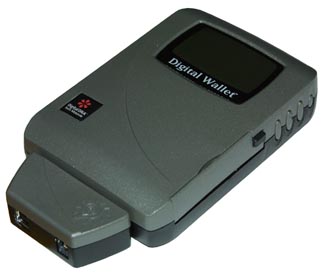Pictures in Your Pocket: The Minds@Work Digital Wallet
We all know you can never have too much storage. If you’re a digital camera owner, however, you’ve probably come to realize that “having too much” is not as much of an issue as “being able to afford enough.” Fortunately, Minds@Work’s Digital Wallet is a good alternative for digital photographers who can’t afford lots of flash memory cards. Though it won’t add storage directly to your camera, this portable hardware device does provide a quick way to clear off your flash cards without having to carry around a computer.

With its 6GB capacity and long battery life, the Minds@Work Digital Wallet should give you all the storage you need when you head out with your digital camera, even when heading out means being gone several days.
Weighing 12 ounces and measuring about the same as a paperback book (3.7 by 5.2 by 1.1 inches), the Digital Wallet is a stand-alone mass storage device: a 6GB, battery-powered hard drive with a USB connection on one end, a media slot in the other, and an LCD on top, all fueled by a Motorola ColdFire microprocessor. Priced at $499, the Digital Wallet comes in at around 8 cents per megabyte. With flash cards typically costing around $2 to $4 per megabyte, the Digital Wallet is a real bargain.
How Much Would You Pay?
Basic operation of the Digital Wallet is simple: To upload a card-full of images, you simply insert your camera’s memory card into the media slot (it supports PC Card and CompactFlash out of the box, but adapters for other media are available) and select Download Content from the Digital Wallet’s LCD menu. The Digital Wallet will copy the contents of your media card, freeing you to erase the card and re-use it.
To reduce the size of the Digital Wallet, Minds@Work has placed the USB and AC ports on a separate docking attachment — a small module that plugs into the bottom of the Digital Wallet. The basic package also includes an AC adapter, a CompactFlash adapter for the Digital Wallet’s PC Card slot, and a smattering of software. The warranty is for one year.

A separate module that plugs into the bottom of the Digital Wallet provides the connector for the USB port and AC adapter/charger.
Setting up the Digital Wallet involves little more than inserting the batteries and giving the unit a charge. It uses a proprietary battery pack, so you won’t be able to use any rechargeables you may already have on hand. Fortunately, a spare battery pack is only $20.
You insert the batteries into the top of the unit. Getting them installed provides the first indication that the Digital Wallet’s construction may leave a little to be desired. Though the unit is made of sturdy plastic and has a solid feel, its port covers are very flimsy and difficult to open and close.
Unfortunately, the battery pack doesn’t simply drop into its receptacle. Rather than having simple contacts, the battery pack depends on a cable that must be connected to a cable inside the Digital Wallet. Getting everything in place involves a good amount of cramming, augmented by a little shoving. We were pleased to discover that no cursing was required, but don’t plan on being able to quickly swap battery packs in a pinch.
The Digital Wallet batteries charge fully in about 2.5 hours, and Minds@Work claims that a full charge will deliver about 140 minutes of average use. This may not sound like much, but remember that you’ll only be starting up the device when you are ready to download, and then you’ll only be leaving it on long enough to make your transfer.
Though we didn’t perform any formal tests, we did find that a single charge consistently provided several days worth of “average” field shooting (around 500MB of transfer per day). Conceivably, the higher power requirements of IBM Microdrives would tax the Digital Wallet’s batteries more, but we were not able to test this.
Moving Pictures
The Digital Wallet comes with a PC Card CompactFlash adapter for downloading your pictures. For those with cameras that use SmartMedia, an adapter is available from the MindsGear Web site (MindsGear is the online store for Minds@Work products) for $50. An adapter for the Sony Memory Stick will be “available soon,” according to Minds@Work. If you’re using an older camera that uses PC Card flash memory, or a PC Card hard drive, you’re in luck: Either can be inserted directly into the Digital Wallet. Finally, the Digital Wallet also supports IBM Microdrives (using a CompactFlash adapter).
File transfer was very speedy, offering somewhere between 1 and 1.5 megabytes per second, depending on the speed of the media card we were using. The Digital Wallet itself builds on a 2.5-inch, 4,500-rpm Toshiba hard drive with an average seek time of 13ms.
The built-in LCD and three side-mounted buttons provide access to the simple menu system, which allows you to examine the contents of the hard drive, determine free disk space, read the size of the last download, and check battery power. The Digital Wallet stores an entire card’s contents into a numbered folder. Unfortunately, you cannot browse within a folder to find out what’s inside.
The Digital Wallet often didn’t recognize our media cards unless we inserted them before powering up. If we tried to insert a card after selecting download, the unit just kept waiting for us to insert the already-present card. Minds@Work says that the recently available firmware upgrade should help with this issue, but that some brands of CompactFlash memory are more prone to this problem than others. (Should this happen to you, a quick way to shut off the Digital Wallet is to hold down the “Select” menu button for 10 seconds. Otherwise, wait till the Wallet shuts itself off after 30 seconds).
As with the battery cover door, the PC Card port cover feels shoddy and is difficult to get latched. Hopefully, future versions of the product will sport an improved industrial design.
First Down (Then Up)
When you’re ready to retrieve your images, you can tell the Digital Wallet to upload them back to a media card (of appropriate size, of course) for viewing on your camera or transferring to your computer.
Better still, you can simply attach the unit’s docking station and use its USB port to connect the Digital Wallet to your computer. Once it’s powered up, it will appear on your desktop as another volume. You can then drag and drop files to and from your computer’s drives.
For the most part, this process worked flawlessly, but there were some folders on the Digital Wallet’s drive that would not show up when the unit was attached to our Macintosh. An apparent bug in the shipping version of the Digital Wallet firmware (version 1.46DL) caused some folders to be marked as invisible when mounted on a Mac. As we posted this article, Minds@Work had already posted a firmware fix for this problem on the Minds@Work Web site.
Conclusion: Pocket This Wallet
The Digital Wallet does have a few troubles, ranging from slight firmware issues to its cheap-feeling port covers. However, these issues are minor and don’t compromise the utility of the device. Some people might be concerned about keeping all of their eggs in one Digital Wallet and, yes, if the drive crashed after a week’s vacation you could lose everything (if Minds@Work couldn’t salvage the files for you). However, our digital wallet has thus far spent several weeks in various coat pockets walking and bicycling through the steep, bumpy San Francisco hills, and we’ve lost nary a byte.
For the photographer who needs to shoot a lot of pictures in the field but doesn’t want to lug around a laptop, (and who doesn’t have piles of cash to spend on media cards) the Digital Wallet is the ideal solution.




I’m impressed. You’re truly well informed and very intelligent. You wrote something that people could understand and made the subject intriguing for everyone. I’m saving this for future use.
Claire
http://www.imarksweb.net
Marks Web